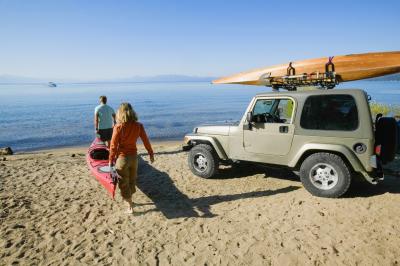
American Motors knew when it released the Wrangler in 1987 that it was playing with fire. Designed to replace one of the most beloved and time-tested vehicles ever produced, the Wrangler might have been something of a bomb for the company had it not been so almost-universally well-received. It remains something of a testament to AMC that, almost 20 years after it went out of business, Chrysler was still using engines that AMC had designed back when people knew who Walter Mondale was.
Engines produce two kinds of power: torque and horsepower. Torque is the amount of physical force -- expressed in foot-pounds -- the engine produces per crankshaft revolution. Horsepower is the amount of torque an engine produces combined with its rpm; horsepower is a measurement of work performed over time. Think of it this way: You've got two men carrying buckets of water up a hill. One man is strong but slow, carrying 20 gallons at a time and making the trip 20 times in an hour. The other is weaker but faster, carrying 10 gallons at a time but making 40 trips in an hour. They've both carried 400 gallons of water in an hour -- exerted the same amount of horsepower -- but the smaller man compensated for is lack of strength -- torque -- by doing his work faster, or at a higher rpm.
All engines have an rpm at which they operate with peak efficiency, or do the best job of converting fuel into energy by combining it with oxygen. In most cases, an engine will use the least amount of fuel from about 1,500 rpm below its torque peak to the torque peak. The engine's peak horsepower rpm -- where it does the most amount of work for a given period of time -- offers the best acceleration but also tends to coincide with the point of worst fuel economy. The rpm band between the engine's peak torque and peak horsepower is known as the "power band." Extracting maximum performance means shifting so you keep the engine as close to the horsepower peak as possible, while getting the best fuel economy means keeping it as close to the peak torque as possible.
Most of the Wrangler's four-cylinder engines actually descend from the old American Motors four-cylinder. American Motors purchased Jeep from Kaiser in 1970 and sold the division to Chrysler when it went out of business in 1987. Chrysler used the old 2.5-liter AMC four-cylinder all the way through 2003, when it went away in favor of Chrysler's own 2.4-liter PowerTech. Older 1982 through 1986 Jeeps using carburetors will get the best fuel economy by keeping rpm between 2,000 and 2,800, and get the best acceleration keeping it around 5,000 rpm. Later fuel-injected 2.5-liters will prove most efficient when shifted between 2,200 and 3,500 -- use higher rpm for higher gears -- and will provide the best acceleration when shifted at between 5,200 and 5,300 rpm. The more sophisticated 2.4-liter should return the best economy by keeping rpm between 2,000 and 2,800 rpm and the best acceleration by shifting at between 5,200 and 5,300 rpm.
The Wrangler has used four different six-cylinders: the AMC-sourced 4.0-liter and 4.2-liter inline-sixes, and the Chrysler-sourced 3.6- and 3.8-liter V-6s. While the 4.0-liter's torque doesn't peak until about 3,000 rpm -- depending upon the model year -- it makes enough torque off-idle that you should get the best fuel economy by keeping the rpm as low as possible -- between 1,000 and 2,000 rpm, depending upon the gear. The less-sophisticated AMC 4.2-liter produces less torque and peaks at between 1,800 and 2,000, so you'll likely get the best fuel economy shifting at 1,200 to 2,000 rpm. The 4.2-liter should return the best acceleration when shifted at 3,200 to 3,400 rpm -- which keep it close to its 3,200 horsepower peak -- while the 4.0-liter will do better when shifted at between 4,600 and 4,800 rpm
Both the 3.8-liter and 3.6-liter peak at staggeringly high rpm -- 4,000 and 4,800. But they also use modern technology like variable-length intake runners and variable valve timing to boost torque at low rpm. With the 3.8-liter, you should get the best fuel economy shifting from 1,800 to 3,000 rpm, depending upon the specific weight and transmission. You'll want to target about 2,500 rpm to get the heavy JK chassis moving. The dual-overhead-cam 3.6-liter is a revvier beast by nature, so it'll do better with about 500 rpm more than its bigger brother. The 3.8-liter's horsepower peaks at 5,000 rpm, and you should target rpm there or slightly higher for peak acceleration. The 3.6-liter produces its peak 305 horsepower at a fairly stratospheric-for-a-Jeep 6,350 rpm; shift at between 6,400 and 6,500 to keep the 3.6-liter on boil for maximum acceleration.